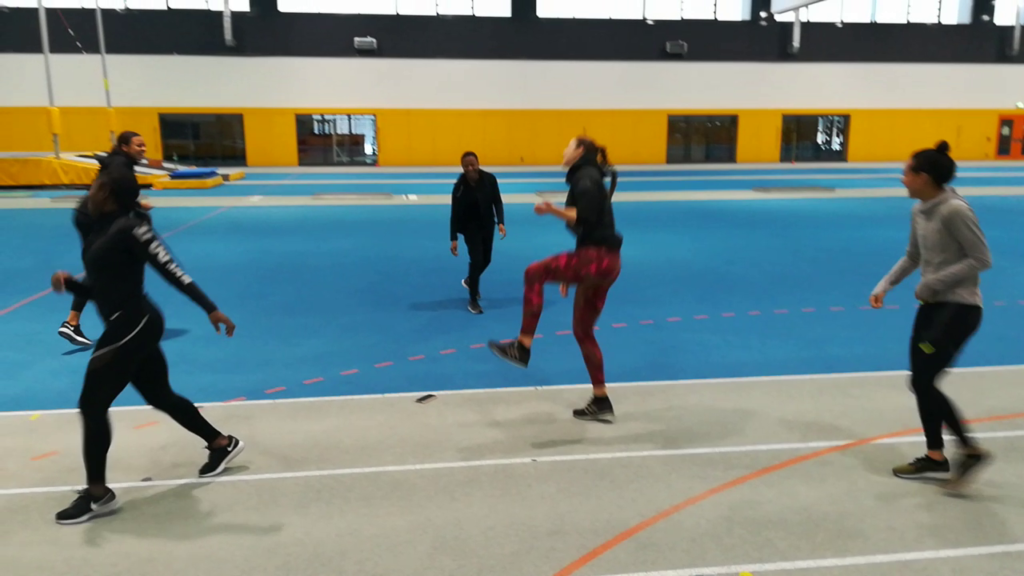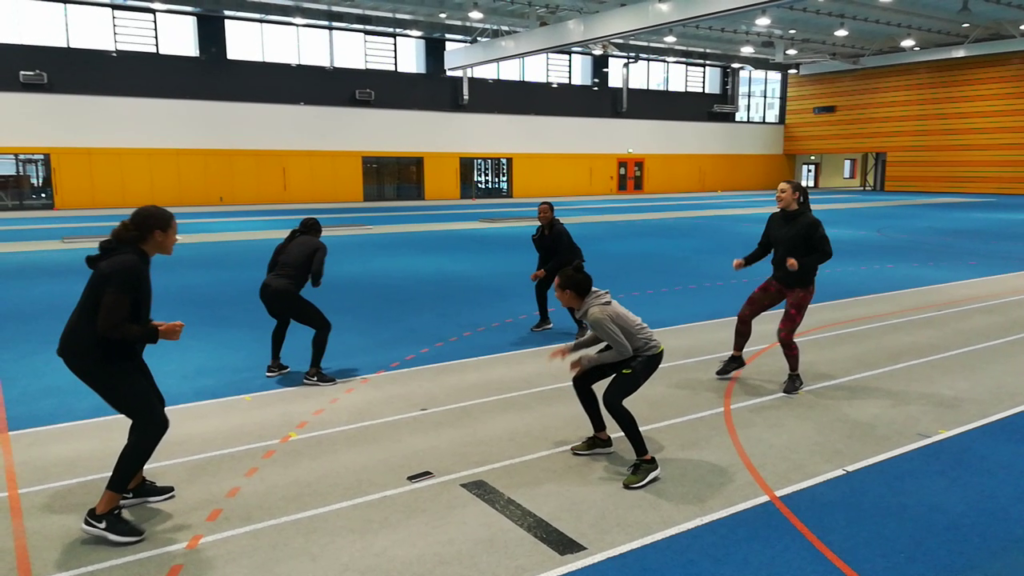Is there an “I” in team?
An often heard commonplace in the Netherlands, repeated like a thoughtless mantra, when talking to team coaches about the relationship between the role of the individual and the team: “there is no ”I” in team”…….
If there wouldn’t be an “I” in team than there wouldn’t be a team in the first place or like Fergus Connolly said brilliantly when confronted with this popular statement: “No, but there is an “I” in winning……”.
Warming-up
I have been writing about warming up a few times. I consider its purpose to be increasing body temperature and enzymatic activity, preparing the relevant physiological systems such as the autonomic nervous system for action. Most of the time, when preparing for explosive activities, one starts with slow jogging, followed by static stretching. Both are not adequate to prepare for explosive actions.
So, for a change, preparing for a sharp relay training session, I decided to do something else as a warming up.
Working with young women, and seeing them move, performing the dance-moves they see on the social media, they now had to perform their favorite moves for two minutes and the others were to follow. Then, after 2 minutes another athlete would take over. Result: warmed-up athletes after a 10 minutes of fun warming-up!!!


Note: no, I did not participate, my dancing looks like a combination of John Cleese and Mr. Bean….
The black hole of information
I have been writing about this phenomenon before. And the more I think about it, the more I see my statement is justified. Just one recent example – I can easily bore you to death with many more.
This week in the magazine Runners: a new, useful supplement for sports: L-Carnitine, it is found in lamb meat and it helps the mitochondria to burn fats. Wow! ……only too bad that even as long ago as being an athlete myself, in the first half of the 1980’s, spending time in the national training camp for sprint in Formia, Italy, carnitine was already well-known and common supplement for athletes, produced by Sigma-Tau. In 1982 carnitine even made the headlines, since the Italian national soccer team became world champion “thanks to the use of carnitine”.
So, what is now promoted as being “new”, “state-of-the-art” or “innovative” is basically knowledge or information that has been forgotten, overlooked, neglected, banned or ignored.
What to do? A basic question
Here we are, on the track, coaching an event e.g. 100 meter sprint, an athlete who wants to train, a date to perform e.g. the national championships…… now what? Which exercises is the athlete going to perform in order to run faster in competition in a month from now?
This looks like an easy question, but the answer is much more complex. Some basic thoughts might help to sharpen our minds.
What are the basic considerations here?
- we do this exercise because I have done this exercise myself (many coaches (often) have been average athletes themselves). I know this exercise, I know how it works and I know that it works (for me, at least). So basically this is the heritage of my own coach when I was his athlete. (“heritage approach”).
- we do this exercise because I have seen Usain Bolt and other elite sprinters doing this drill, so it must be good. In other words, if this exercise would not be good or harm, they would not perform this exercise or else they would not be running that fast. ( “copy-the elite approach”).
- we do this exercise because every sprinter in the world is doing this exercise. Go to watch any sprinter of any level train at any place in the world and you will see this exercise, so this exercise is an indispensable part of sprint training. Basically: everybody is doing it, so it must be good. (“indispensable approach” or “common sense approach“).
- we do this exercise because it was researched in a sport science article or review and it worked better than other exercise to improve speed. A scientific approach to training? A research project with mediocre sprinters over 2 months is something else than our workouts over 10 years, being a national champion or an international elite athlete (“scientific approach”) .
- we do this exercise, because on the internet there was an article by a fitness guru who stated that this was the “king of sprint exercises”. He should know, shouldn’t he? After all he “worked with” hundreds of “elite sprinters” and he wouldn’t be the guru if he hadn’t done this (“follow-the-guru approach”).
I bet that your approach is a combination of all approaches above, an eclectic cocktail of all these so called common sense approaches. But think about it: all of these approaches in the core neglect the unique demands of running 100 meter at top speed AND the unique qualities, strengths and weaknesses of your athlete. These exercises were often used other purposes and for other athletes. And sometimes in other events, e.g. bench press.
My aim is to make us think about better ways to establish our choice of exercises and to create a more optimal training program for each and every individual athlete.
No, it isn’t an easy task, but if someone ever told you this was an easy job, he/she has been lying to you.

Finally!
A sensible, individual effective approach.
Where the athlete is the main and only truthsayer whether an exercise feels and looks totally right
Hello Jack, thanks for your contribution, raising some interesting issues. In my opinion the athlete is the main, but certainly not the only truthsayer. The role of the coach is still to make a proper choice out of the thousands of different possible exercises and the proper combination and timing of these exercise. We cannot have the athlete make his or her proper choices only, it will create too much conscious thinking and doubts. Many federations and coaches talk about “ownership” or he athlete being responsible for his/her own training process. No matter how true this might seem, ask yourself this question: how many athletes that you have coached e.g. came up with their own, self-invented exercise, one they haven’t copied from somewhere or somebody else? Ask far as I can see, 99.99 % of the exercises are designed by coaches. To consider also: the athletes feeling about an exercise might be deceiving and if it looks right, it might not always be right it’s just external feedback, we don’t know/see what is happening inside the body of the athlete (internal processes) and certainly not the long term effects of the exercise. Another issue is: what is “looks right”? What looks right for one coach might look terrible or even be considered to be an error in the eyes of another coach. We all might be looking at different parameters for an exercise to be judged “right”.
I love it Henk.
I used to find myself in many of the categories you listed above and looked for easy cook book recipes to train athletes for their goal. Through my mentors I have come to learn there is no good or bad exercises, “there just is” and you have to test and find what the exercise is, meaning what does it create or stimulate. For myself, training mainly field sport athletes (hockey, basketball, lacrosse and soccer), I always followed published written guidelines for training the bio-energetic demands of their sport/position. For the past year and half I have used NIRS technology to look at muscle oxygen and total hemoglobin trends to get a different picture of the physiology, meaning what do our workouts create and stimulate.